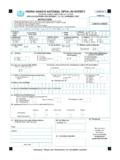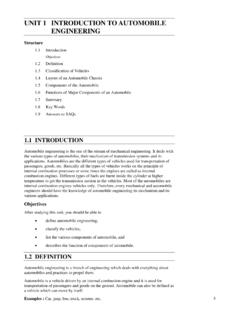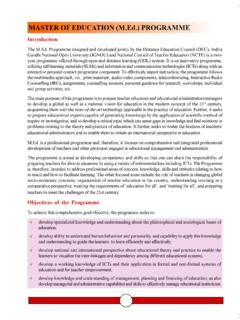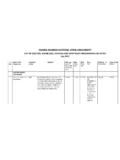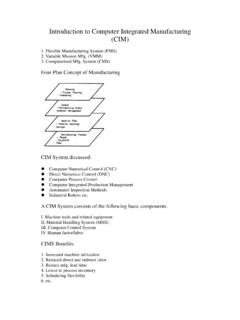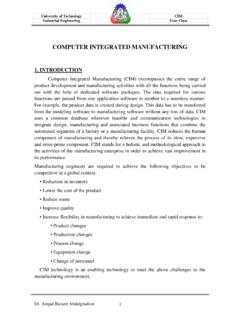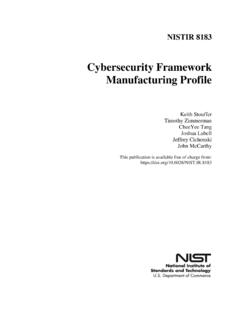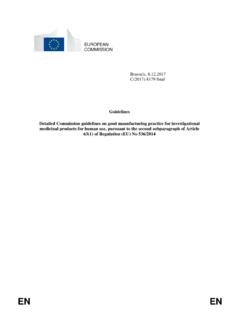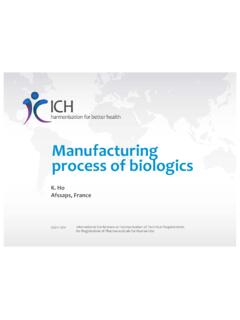Transcription of UNIT 6 FLEXIBLE MANUFACTURING SYSTEM - IGNOU
1 UNIT 6 FLEXIBLE MANUFACTURING SYSTEM Introduction Flexibility and its type FMS and its rule in CIM environment Machine loading numerical example Problem description Solution methodology Exact heuristic by Reallocation paradigm Numerical illustration Scheduling Definition Dispatching rules Numerical Example Methods and practical applications Control of FMS SYSTEM Recent trends Summary keywords References INTRODUCTION Globalization, fickling market requirements and modern lifestyle trends have put up tremendous challenge to MANUFACTURING industries. In the current business scenario the competitiveness of any MANUFACTURING industry is determined by its ability to respond quickly to the rapidly changing market and to produce high quality products at low costs. However, the product cost is no longer the predominant factor affecting the manufacturers perception. Other competitive factors such as flexibility, quality, efficient delivery and customer satisfaction are drawing the equal attention.
2 MANUFACTURING industries are striving to achieve these capabilities through automation, robotics and other innovative concepts such as just-in-time (JIT), Production planning and control (PPC), enterprise resource planning (ERP) etc. FLEXIBLE MANUFACTURING is a concept that allows MANUFACTURING systems to be built under high customized production requirements. The issues such as reduction of inventories and market-response time to meet customer demands, flexibility to adapt to changes in the market, reducing the cost of products and services to grab more market shares, etc have made it almost obligatory to many firms to switch over to FLEXIBLE MANUFACTURING systems (FMSs) as a viable means to accomplish the above requirements while producing consistently good quality and cost effective products. FMS is actually an automated set of numerically controlled machine tools and material handling systems, capable of performing a wide range MANUFACTURING operations with quick tooling and instruction changeovers.
3 FLEXIBILITY AND ITS TYPES Flexibility is an attribute that allows a mixed model MANUFACTURING SYSTEM to cope up with a certain level of variations in part or product style, without having any interruption in production due to changeovers between models. Flexibility measures the ability to adapt to a wide range of possible environment . To be FLEXIBLE , a MANUFACTURING SYSTEM must posses the following capabilities: Identification of the different production units to perform the correct operation Quick changeover of operating instructions to the computer controlled production machines Quick changeover of physical setups of fixtures, tools and other working units These capabilities are often difficult to engineer through manually operated MANUFACTURING systems. So, an automated SYSTEM assisted with sensor SYSTEM is required to accomplish the needs and requirements of contemporary business milieu. FLEXIBLE MANUFACTURING SYSTEM has come up as a viable mean to achieve these prerequisites.
4 The term FLEXIBLE MANUFACTURING SYSTEM , or FMS, refers to a highly automated GT machine cell, consisting of a group of computer numerical control (CNC) machine tools and supporting workstations, interconnected by an automated material handling and storage SYSTEM , and all controlled by a distributed computer SYSTEM . The reason, the FMS is called FLEXIBLE , is that it is capable of processing a variety of different part styles simultaneously with the quick tooling and instruction changeovers. Also, quantities of productions can be adjusted easily to changing demand patterns. The different types of flexibility that are exhibited by MANUFACTURING systems are given below: 1. Machine Flexibility. It is the capability to adapt a given machine in the SYSTEM to a wide range of production operations and part styles. The greater the range of operations and part styles the greater will be the machine flexibility.
5 The various factors on which machine flexibility depends are: Setup or changeover time Ease with which part-programs can be downloaded to machines Tool storage capacity of machines Skill and versatility of workers in the systems 2. Production Flexibility. It is the range of part styles that can be produced on the systems. The range of part styles that can be produced by a MANUFACTURING SYSTEM at moderate cost and time is determined by the process envelope. It depends on following factors: Machine flexibility of individual stations Range of machine flexibilities of all stations in the SYSTEM 3. Mix Flexibility. It is defined as the ability to change the product mix while maintaining the same total production quantity that is, producing the same parts only in different proportions. It is also known as process flexibility. Mix flexibility provides protection against market variability by accommodating changes in product mix due to the use of shared resources.
6 However, high mix variations may result in requirements for a greater number of tools, fixtures, and other resources. Mixed flexibility depends on factors such as: Similarity of parts in the mix Machine flexibility Relative work content times of parts produced 4. Product Flexibility. It refers to ability to change over to a new set of products economically and quickly in response to the changing market requirements. The change over time includes the time for designing, planning, tooling, and fixturing of new products introduced in the MANUFACTURING line-up. It depends upon following factors: Relatedness of new part design with the existing part family Off-line part program preparation Machine flexibility 5. Routing Flexibility. It can define as capacity to produce parts on alternative workstation in case of equipment breakdowns, tool failure, and other interruptions at any particular station. It helps in increasing throughput, in the presence of external changes such as product mix, engineering changes, or new product introductions.
7 Following are the factors which decides routing flexibility: Similarity of parts in the mix Similarity of workstations Common tooling 6. Volume Flexibility. It is the ability of the SYSTEM to vary the production volumes of different products to accommodate changes in demand while remaining profitable. It can also be termed as capacity flexibility. Factors affecting the volume flexibility are: Level of manual labor performing production Amount invested in capital equipment 7. Expansion Flexibility. It is defined as the ease with which the SYSTEM can be expanded to foster total production volume. Expansion flexibility depends on following factors: Cost incurred in adding new workstations and trained workers Easiness in expansion of layout Type of part handling SYSTEM used Since flexibility is inversely proportional to the sensitivity to change, a measure of flexibility must quantify the term penalty of change (POC) , which is defined as follows: POC = penalty x probability Here, penalty is equal to the amount upto which the SYSTEM is penalized for changes made against the SYSTEM constraints, with the given probability.
8 Lower the value of POC obtained, higher will be the flexibility of the SYSTEM . SAQ 1. Define flexibility. Discuss various types of flexibility? 2. Describe the essentiality of flexibility in shop floor environment? As discussed in above section, FMS ensures quality product at lowest cost while maintaining small lead-time. So, firms adopt FMS as a means of meeting burgeoning requirements of customized production. Main purpose of FMS is to achieve efficiency of well-balanced transfer line while retaining the flexibility of the job shop (Stecke, 1983, 1985). A FLEXIBLE MANUFACTURING SYSTEM (FMS) has four or more processing workstations connected mechanically by a common part handling SYSTEM and electronically by a distributed computer SYSTEM . It covers a wide spectrum of MANUFACTURING activities such as machining, sheet metal working, welding, fabricating, scheduling and assembly. Advantages of processes involved in FLEXIBLE MANUFACTURING SYSTEM over the convectional methods are: Item FLEXIBLE Conventional Set-up Defined Varies Volume Low-Medium Medium-High WIP (work-in-process) Low High Flexibility High Low Scrap Low Unpredictable Labor Low High Equipment cost High (short term) Low (short term) Equipment ROI Low High Plant ROI High Low Queuing Low High Automation High level Low level Future Lead to integration Dead end Quality Controlled Varies Inspection Automatic tie-in Doesn t flow Tooling and fixturing FLEXIBLE Rigid Market changes FLEXIBLE Rigid FMS AND ITS RULE IN CIM ENVIRONMENT Stable Stable Stable Variable Variable Variable SPECIAL SYSTEM FMS JOB SHOP Equipment utilization Optimized Low Production control Predictable Unpredictable Lead time Low High Engineering changes Easier Equipment and time constraints Source: Modern machine shop, September 1984.
9 Table Comparison between attributes of FLEXIBLE and conventional MANUFACTURING systems Another strategic advantage of FMS is that it is able to handle the risk caused by uncertainty about the future. It can be done through planning in a way that maintains flexibility of the environment. Although it is impossible to predict the future, one can make estimates of probabilities and proceed in ways to accord with the future. The simple decision tree in figure illustrates the decision-making in case of FMSs governing the choices among three different options depending upon the nature of the market. Figure Simple Decision Tree 100 30 90 90 45 100 The first option is a specialized MANUFACTURING SYSTEM that performs well in stable market (payoff = 100) but will perform poorly (payoff = 30) if the market is variable. The second option, the FMS, will perform fairly well (payoff = 90) regardless of the type of market.
10 The third option is the job shop that will perform well in variable (payoff = 100). From the example it is clear that an FMS performs less well then a specific option in specific market but proves to be a fairly good performer when the nature of market is not defined. As a conclusion, FMS technology can be termed as an evolutionary step beyond transfer lines that enables the industries to accommodate the growing costumer demand and maintain the quick delivery of customized products. It is the newest wave in attaining greater productivity with instant positive response to both adversities and new opportunities. TYPES OF FMS: FLEXIBLE MANUFACTURING systems can be divided into various types depending upon their features. They all are discussed below: 1. DEPENDING UPON KINDS OF OPERATION- FLEXIBLE MANUFACTURING SYSTEM can be distinguished depending upon the kinds of operation they perform: I.

